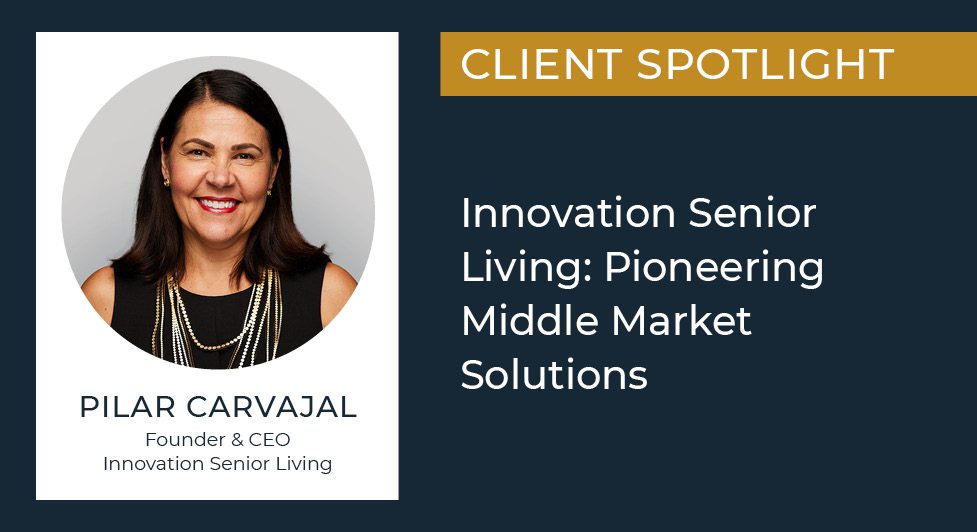As a social entrepreneur, Pilar Carvajal strives to create businesses that not only turn a profit but that also address pressing unmet societal needs. With Innovation Senior Living, she has found a way to do both.
Carvajal launched Innovation in 2016 to provide housing options for middle-market seniors—individuals 75 and over whose incomes are too high for them to qualify for Medicaid but too low for them to afford most private pay seniors housing.
This is a large and growing segment of the population. The National Investment Center for Seniors Housing & Care (NIC), which has published a report on the middle market, estimates that this group will reach 14.4 million by 2029. “The demographic is huge and the need largely unmet,” Carvajal said. “I wanted to pioneer a model for serving this group that other entrepreneurs could emulate.”
Carvajal sat down with Lument to discuss what it takes to deliver service-enriched living at a comfortable price point for seniors of modest means, those whose incomes fall in between the 41st and 80th percentile nationally. Currently, Innovation owns and/or operates eight communities in Florida.
Lument: What inspired you to take on this challenge?
Carvajal: I was working in New York doing M&A for Accenture when September 11th happened—and I decided it was time for me to move back to Florida. My mother had just finished her appointment as Secretary of Aging and Adult Services for Governor Lawton Chiles Jr.—she was the first Hispanic female to hold a cabinet secretary position in Florida—and together we started a company to provide senior living services to low-income residents in public and subsidized housing.
I had the business experience, and my mother the seniors expertise—as secretary, she wrote the Medicaid waiver for the State of Florida. We became very proficient at using government subsidies for this population, and the business was a tremendous success. We licensed the first 100-unit senior-designated public housing property and went on to serve as consultants and managers for similar communities across 23 states and the District of Columbia.
Early on, I noticed that we were attracting a new resident type—a private pay, middle-income senior—who had never lived in public housing before. I saw that there was an opportunity to build communities that would focus on their needs.
Lument: Part of your model has turned out to be size.
That’s right. On the affordable side, you have to be big to make a profit, but I thought with middle market I could start small. In fact, I probably started too small. In 2017, I bought a 24-bed, 18-unit property, and operating it proved a challenge. But I learned a lot in the process—and I think I’ve found a happy medium. Two communities we recently purchased with financing from Lument are 45-bed properties.
Focusing on this size has a lot of advantages. First of all, the senior living industry gravitates toward properties with 80 units or more, so there’s much less competition for these properties, and they’re available at attractive prices.
I then use my expertise in the Medicaid side to expand the customer base. I licensed both 45-unit properties at 60-beds, transforming 15 units into semiprivate rooms that Medicaid accepts for its clients. In other words, I was able to increase their value without expanding their footprint.
Lument: Adding beds clearly makes a real difference on the revenue side. What’s your approach to the expense side of the equation?
Carvajal: Even with the added scale, this model works with very strict expense controls. We simply don’t have big pockets. One way I control labor costs is by training employees to take on a variety of roles. For instance, we don’t have separate food servers. Delivering meals is the responsibility of resident care staff.
Partnering is another important tactic that keeps costs down. I bring in hospice services, Medicare Advantage providers, therapy, and more, offering services residents appreciate without the overhead of providing them myself.
Technology also plays a role. I have created an online portal for monthly payments, so we don’t have the costs of processing checks. Altogether, there are dozens of little things we do that add up to real savings—and I’m always on the lookout for more. With each transaction, we fine-tune our expense controls even more.
Lument: Given all these changes, you must really have to hit the ground running.
That’s exactly right—but putting in expense controls is only part of what we focus on during the first three months. Within 30 days of acquisition, we are inspected by the State of Florida. It’s all hands on deck from day one to make sure we get the property into compliance. We are getting better during our due diligence at determining what we need to do to get a deficiency-free survey.
And because we use bridge-to-HUD financing, we use the first 90 days to make critical repairs needed for HUD financing, typically to meet Americans with Disabilities Act (ADA) requirements. At the same time, we address such major maintenance issues such as roof replacement.
There’s a lot to track. I have a facility transition list that I work through with my team on a weekly basis. With each acquisition, we incorporate lessons learned, refining this document so that we do even better on the next acquisition.
Lument: This sounds like a lot for families and residents to absorb. How do you get them on board?
Carvajal: Communications is the key—and for me that means showing up. On the first day after acquisition, I am at the property, meeting with staff and sending letters to families to set up a town hall meeting, which I use as a forum for explaining what we’re trying to achieve and how we plan to do it. I schedule a series of follow-up town halls to continue to build trust. Getting in front of people and heading off misconceptions can help things go more smoothly.
I’m also hands-on in working with staff. My staff know that I roll up my sleeves, and I’m there with them. I am very conscious that as a woman and a Latina, I can serve as a role model for many of them. And I’ve been successful in rallying them around the idea of finding a way to serve the middle market. Typically, they’ve worked at other properties, and they understand industry dynamics.
Lument: You mentioned bridge-to-HUD financing. What do you look for in your lenders?
Carvajal: Obviously, we need to find lenders who are willing to take a chance on a new model—and they have to appreciate the tremendous untapped potential of serving the middle market. Equally important, they have a track record of working with HUD—and they also have to work efficiently to move us toward closing.
Casey Moore and his team at Lument met our needs on all counts. I particularly liked the clarity they provided, from the term sheet all the way to closing. Everything was spelled out and clearly communicated. And having the Lument M&A team represent the seller streamlined and accelerated the process. We were able to get all the information we needed for our due diligence in a timely manner.
Lument was also flexible when we needed it to be. A hurricane came through the day before closing, but we all worked through it. At the end of the day, it’s a relationship. You have to like each other and like to work with each other. And that’s the kind of relationships we have with Lument.
Lument: After all this work, where do you see Innovation going?
Carvajal: We’re planning to have assembled a portfolio of 15 to 20 profitable properties in the next few years—and, in the process, demonstrate conclusively that our model is viable. I participate in a number of industry organizations like the Senior Living 100 Advisory Board. They give me the platform to say to my peers that it’s possible for you to make money and give your equity investors a return while serving a middle-market population that desperately needs the services you can provide. You should give it a try.

